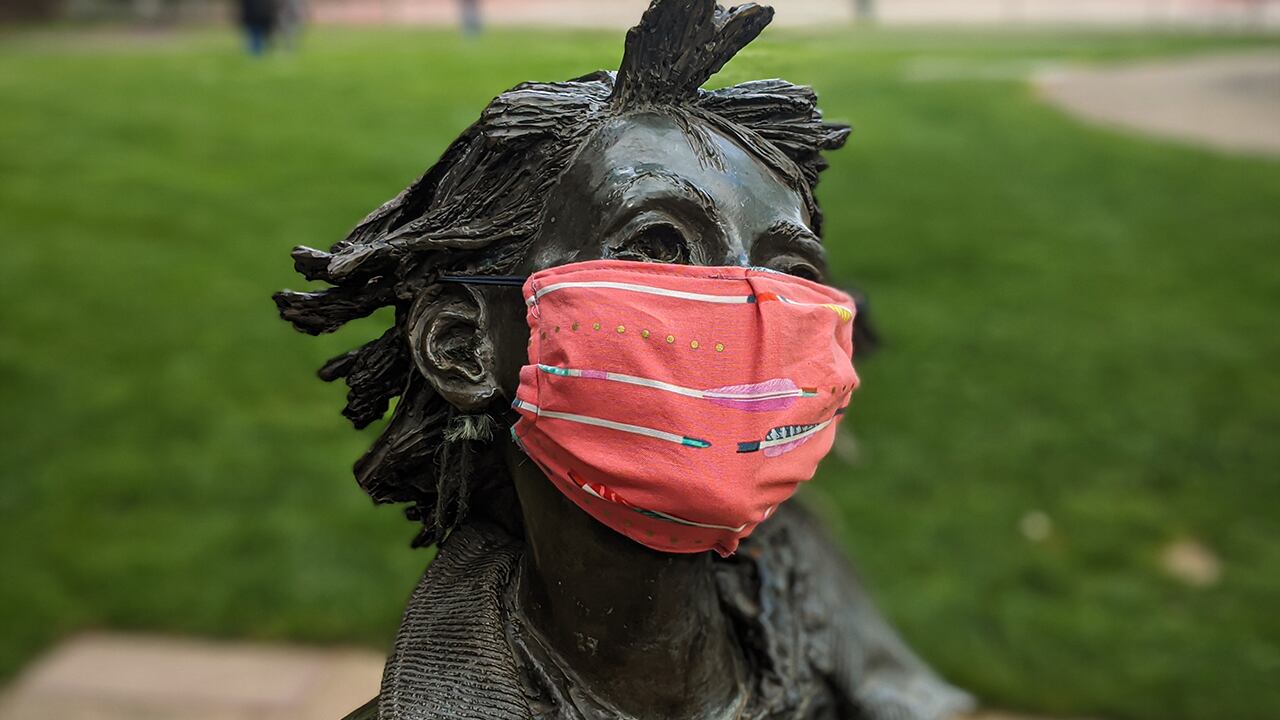This week, Oregon will administer its one millionth dose of COVID-19 vaccine. In all, 15% of Oregonians have received at least one shot, with President Joe Biden promising enough vaccines for all American adults by end of May.
Time to throw away that uncomfortable face mask? Nope.
More contagious variants of the virus are arriving. And then there's that nagging virtue: altruism.
The science remains unclear whether people fully vaccinated against the coronavirus can transmit COVID to others, even though the shot protects them against serious illness. So you have to wear the mask to keep protecting others.
But there's another reason not to throw out the mask. COVID-19 is not the only illness that a mask can prevent from spreading. Influenza was almost nonexistent this flu season, and local medical experts think that might be thanks to face coverings.
"I don't have a crystal ball, but masks have really proven themselves from a prevention standpoint for respiratory illness," says Dr. Jennifer Vines, the tricounty health officer. "I think there's a chance they may never disappear, now that we're all conscious of these droplets that we have in our nose and mouth."
Dr. John Townes, an Oregon Health & Science University professor of medicine specializing in infectious disease, says there's little downside to continuing to wear masks. But he's not sure if enough people will do it to prevent viral outbreaks.
"The greatest benefit is in containing the source—the people who are breeding the virus," Townes says. "I'm not sure what the level of benefit is if we don't have widespread mask use."
Take a stroll around Portland and you'll already spot a divide. Some of your fellow humans are taking precautions against the virus. Or you may rage at the exceptions, who don't know or care about protecting their fellow citizens by wearing a mask.
Even among the well-intentioned, there are some failings. If you're going to keep wearing that mask, do it right. Here are some pointers.
1. Oregon requires everyone in public to wear a mask.
Yep, you too, Portland jogger. Even if you're not going to follow the rules while outdoors, your obligation is to stay the hell away from other people.
The public health recommendation is that you wear a mask whenever you are within 6 feet of anyone outside your household.
"For anybody who is out and about not wearing a mask, my assumption is they're being very conscious about their physical distance," says Vines (who is being very polite about it).
If public health officials are warning about staying apart and masked outdoors, take that as a signal of the extra urgency of wearing a mask indoors—particularly at, say, newly reopened gyms.
2. Find a mask that is as comfortable as possible.
And make sure it makes contact with your face all the way around the edges. That means: no gaps around the nose. No gaps around the sides of your cheeks.
"Fit is by far the most important thing," says Dr. Vines. "There should be as few gaps as possible."
A wire over the nose is usually best for achieving contact. Adjusting the ear loops may help.
Try different styles. It may require trying a bunch of masks. Be persistent.
"The best mask in the world doesn't function properly if it's not worn properly," says Townes. "And so you need to wear a mask fitted tightly." (Once more for those not paying attention: No valves in the mask and, dear God, cover both your nose and mouth.)
3. Two layers has been the advice from the start of the pandemic.
For cloth masks, that means two layers of tightly woven fabric. But if you can get a tighter fit from wearing two masks, do it.
"That's closing the gaps and getting a good couple layers as added protection," says Dr. Vines. "This is not new."
But again: Fit is key, as is making the masks comfortable enough that they don't require a lot of adjustment. The last thing you want to do is touch your nose or mouth to readjust.
4. It's OK to buy what's called a procedural or surgical mask.
That's different from last year: There's no longer a shortage. But the public is still being asked to save the N95 respirators for medical workers. (The situation with N95s is complicated at the moment. There is a built-up inventory of American-made N95 masks, but experts caution that not enough high-risk professions are wearing them.)
N95s, if fitted properly, can create a seal against droplets. So all this advice on a tight-fitting mask? It's to replicate the fit of an N95.
There is a good way to fold a surgical mask to make it fit that tightly. (Watch a video by the University of North Carolina here.)
5. Don't rely on the mask alone.
Regrettably, masks aren't foolproof. You wear them to protect other people, unlike, say, your bike helmet, which is for your own noggin.
So practice social distancing, particularly indoors.
Wearing masks but standing close together and having a lengthy, laugh-filled joyful chat as if we were in the "before times," particularly indoors, is not recommended.
"A mask is not magical," says Townes. "A mask is just only one of a set of bundled interventions that reduce risks. The most important thing is to reduce the opportunities to come in contact with the virus. That means avoiding crowded spaces, closed spaces that are poorly ventilated, and close conversations with people."

